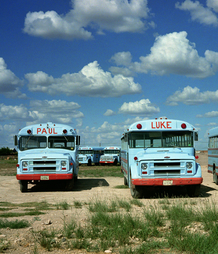
Joshua and John (behind), Odessa, Texas
1983
Lightjet Print
125 x 170 cm
This exhibition is not in Amsterdam but near enough for a day trip or holiday visit.
until 16 August 2015 at Kunstpalash in Düsseldorf,
note: (Monday–Friday 8:00-18:00)
On the occasion of the artist’s 70th birthday in 2015, Museum Kunstpalast in collaboration with Wenders Images and the Wim Wenders Foundation is presenting a selection of 79 large-scale photographs, which invariably are analogue creations, made without artificial lighting or tripod. The exhibits range from artist’s early black-and-white photographs and monumental landscape panorama pictures through to his rarely shown photographs of “Ground Zero” and new works that were made only last year.
If you travel a lot, writes Wim Wenders, if you like roaming about in order to lose yourself, you can end up in the strangest places. I think it must be a kind of built-in radar, which often takes me to places that are either peculiarly quiet or peculiar in a quiet sort of way.
Wim Wenders (born in Düsseldorf in 1945) is internationally renowned primarily for his movies, such as Wings of Desire, Pina and The Salt of the Earth, a portrait of the Brazilian photographer Sebastião Salgado. But the filmmaker acknowledges: Photographic work is the other half of my life. For decades he has created a photographic oeuvre quite independent of his filmic work: photographs of lonely, at times somewhat bizarre places and landscapes, of settings that have their own story.
Wenders started with black-and-white photographs, and later switched to colour photography. In doing so, his interest in photography blended with his passion for painting. Wenders, who initially applied to study at the Academy of Art Düsseldorf without success and in 1967 finally started to study at the then newly-founded College for Television and Film in Munich, discovered the significance of colours for his work: He began to initially “see” a picture for its colours and to define the image section according to the colours.
On many of his photographic works Wenders has written texts, whose rhythms are reminiscent of poems. In these texts he captures his personal impressions, observations and thoughts.
“one can […] use a camera
like a recording device,
which not necessarily only records sounds,
but records what the place has to say.
In the photograph he tells his story,
being both actual history and fiction.
(From: Wim Wenders, A Sense of Place. Texte und Interviews (texts and interviews), ed. by Daniel Bickermann, Frankfurt am Main 2005, p. 36)











